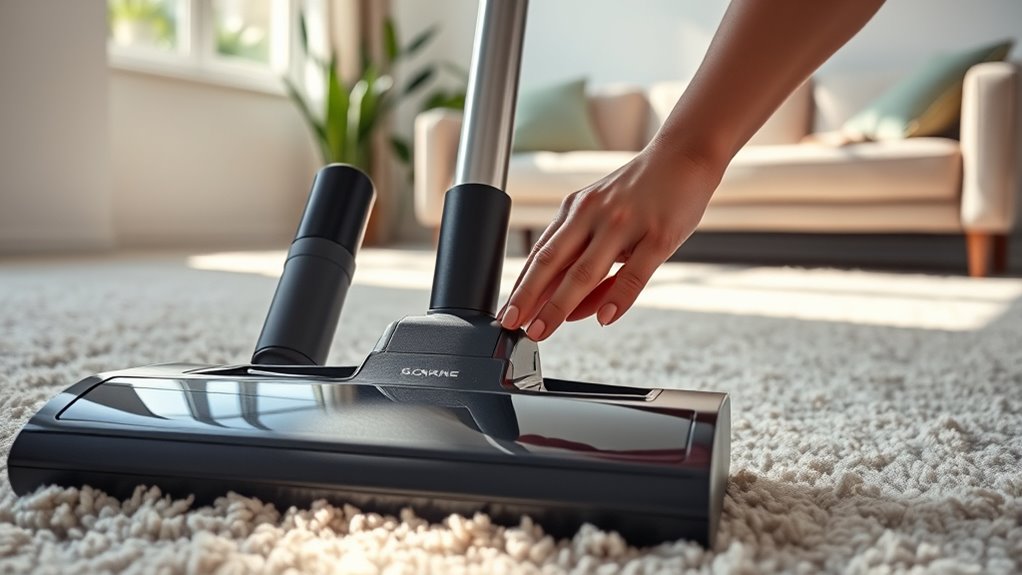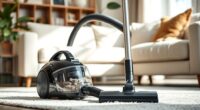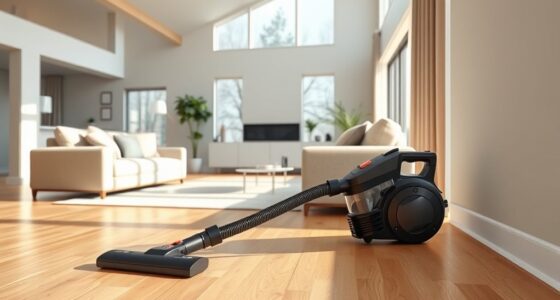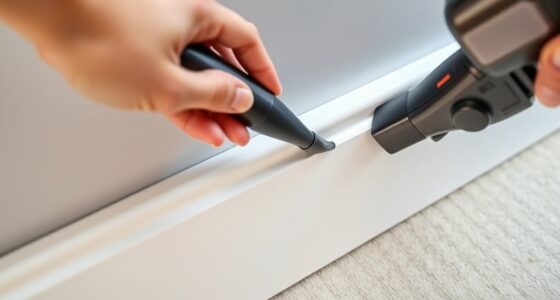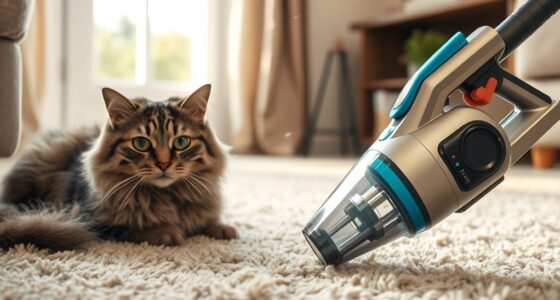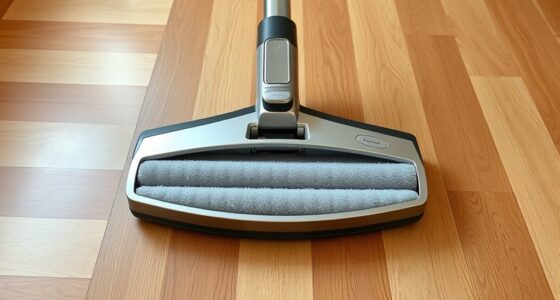To cut cleaning time in half, spend just 10 minutes daily on targeted vacuuming. Focus on high-traffic areas, entryways, and under furniture, using attachments for edges and corners. Keep your vacuum well-maintained—clear brushes, check filters, and empty dustbins—so it works efficiently. Routine inspections prevent bigger issues and maintain suction power. Mastering these simple tasks quickly transforms your cleaning routine—stay with us to discover more effective techniques.
Key Takeaways
- Perform quick daily inspections to clear hair, fibers, and debris from the brush roll and filters.
- Focus on high-traffic areas and entryways to maximize dust removal efficiently.
- Keep your vacuum easily accessible and organized for swift, routine use.
- Use appropriate attachments for targeted cleaning of edges, corners, and furniture.
- Incorporate routine maintenance checks into daily use to prevent buildup and maintain suction power.
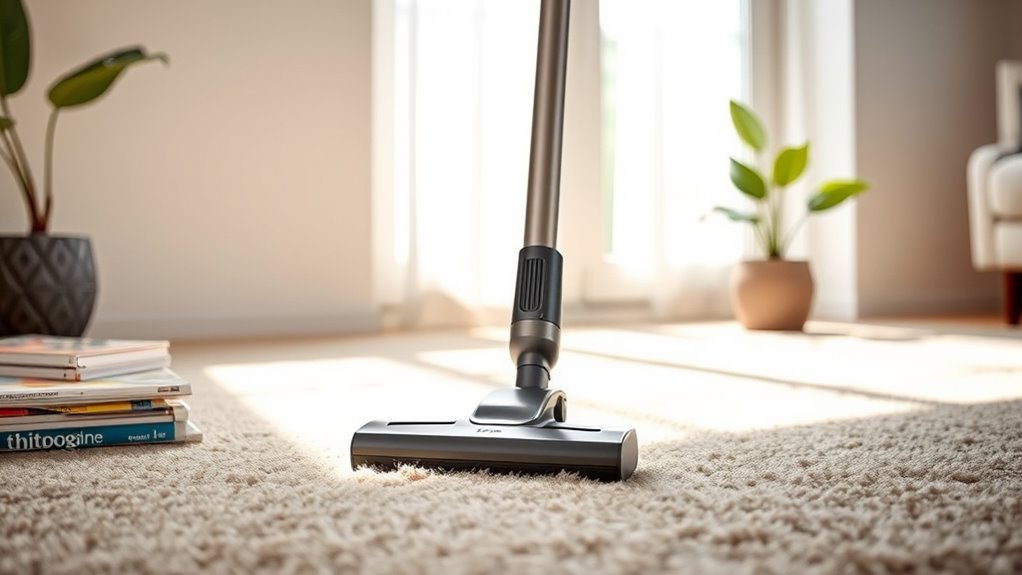
First, it’s important to prioritize vacuum maintenance. A well-maintained vacuum not only performs better but also lasts longer, saving you money and time in the long run. Make it a habit to check the filter and empty the dustbin or replace the bag regularly—preferably after each use or at least once a week. Clear blockages from the brush roll and ensure the wheels move smoothly. These small steps prevent the vacuum from losing suction power and help you clean more efficiently. When your vacuum is in top shape, it becomes a powerful tool for dust prevention, which directly impacts your indoor air quality and reduces allergy triggers. Regularly inspecting your vacuum’s components can also help identify potential issues before they become major problems, ensuring consistent performance. In your daily ten-minute session, focus on strategic areas that accumulate dust and debris the most—entryways, high-traffic corridors, and under furniture. Keep your vacuum accessible in a central location so you’re more likely to stick to your routine. As you vacuum, pay attention to the edges and corners where dust tends to settle. Using the appropriate attachments, like a crevice tool or upholstery brush, can make these tasks quicker and more thorough. Remember, consistency is king—skipping days or doing a rushed job defeats the purpose. In addition, develop a habit of inspecting your vacuum after each use. Remove hair or fibers tangled around the brush, and ensure the filters are clean. This proactive approach minimizes dust buildup in the vacuum itself, which in turn keeps dust from spreading back into the air. The more often you perform these simple maintenance tasks, the less time you’ll need to spend on deep cleans later. Over time, this daily routine becomes second nature, and you’ll find that your home stays cleaner with less effort. Incorporating digital literacy programs can also help you stay informed about new tools and techniques that make routine cleaning easier.
Frequently Asked Questions
Can This Vacuum Habit Reduce Allergy Symptoms?
Yes, vacuuming daily can reduce allergy symptoms. By regularly removing airborne allergens like pollen and dust mites from your floors and upholstery, you prevent these irritants from accumulating and becoming airborne. This habit helps keep your indoor air cleaner, easing breathing and reducing allergy flare-ups. Consistent vacuuming is especially effective if you use a HEPA filter, which traps tiny particles and keeps airborne allergens at bay.
Is This Routine Suitable for Pet Owners?
Yes, this routine is suitable for pet owners. Regular vacuuming helps with pet hair removal and keeps carpets well-maintained, preventing hair buildup. By incorporating a quick daily vacuum, you can effectively manage pet hair and reduce allergens. It saves you time and keeps your home cleaner. Just guarantee your vacuum has good suction and a filter designed for pet allergens, making your routine even more effective.
What Type of Vacuum Cleaner Is Best for This Habit?
For your daily vacuum routine, a cordless model is ideal because it’s lightweight and easy to grab quickly. Look for one with easy vacuum maintenance, like washable filters and simple brush roll cleaning. This way, you won’t waste time on upkeep and can focus on quick, effective cleaning. Cordless vacuums also help you move effortlessly around pets and furniture, making your routine faster and more efficient.
How Often Should I Replace Vacuum Filters?
For ideal vacuum maintenance, you should replace your filters every 3 to 6 months, depending on usage and filter type. Regular filter replacement keeps your vacuum performing efficiently and extends its lifespan. Check your vacuum’s manual for specific recommendations, and don’t forget to clean or replace filters promptly if you notice reduced suction or bad odors. Staying on top of filter replacement ensures your cleaning routine remains quick and effective.
Does This Method Work on All Floor Types?
While some cleaning methods promise universal results, flooring compatibility varies, affecting cleaning effectiveness. You might find that this vacuum habit works well on hardwood or tile, but not as efficiently on plush carpets or delicate surfaces. Always check your vacuum’s settings and manufacturer recommendations to guarantee the best performance across different floor types. Adapting your approach based on flooring ensures thorough cleaning without damaging surfaces or sacrificing efficiency.
Conclusion
Just ten minutes each day keeps your home effortlessly clean and saves you hours later. You might think it’s too little time to make a difference, but this quick habit prevents deep buildup and long cleaning sessions. Stick with it—you’ll notice less dust, fewer allergens, and a tidier space overall. So, don’t let busy days stop you; a few minutes now means a cleaner, healthier home you’ll love coming back to.
